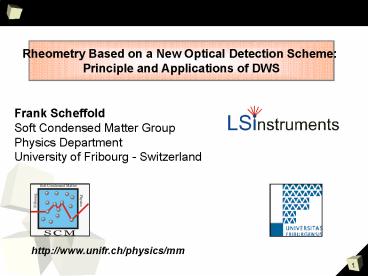Rheometry Based on a New Optical Detection Scheme: - PowerPoint PPT Presentation
1 / 22
Title:
Rheometry Based on a New Optical Detection Scheme:
Description:
... Dodecalactone induced Gelation of Aqueous ... Monitor Gelation. Down to. time resolution 15 sec. 20 ... Critical Gelation Rheology in a 'single shot' 21 ... – PowerPoint PPT presentation
Number of Views:102
Avg rating:3.0/5.0
Title: Rheometry Based on a New Optical Detection Scheme:
1
Rheometry Based on a New Optical Detection
Scheme Principle and Applications of DWS
Frank Scheffold Soft Condensed Matter
Group Physics Department University of Fribourg -
Switzerland
http//www.unifr.ch/physics/mm
2
Thanks !
Pavel Zakharov Echo-DWS
Frederic Cardinaux Microrhelogy, Soft Gels
Peter Schurtenberger
Suresh Bhat Food (Micro)rheology
3
Principle
Microrheology ?? Rheometry
Relates the local thermal motion of a probe
particle (typically 1 mm) to the viscoelastic
moduli G(?), G(?)
Advantages
- Fast -gt measurement time as low 1 minute to
obtain full frequency information - No external shear -gt measures in linear regime
- Extended frequency range w0.1-105 rad/sec
- Small sample volumes required (0.2-2ml)
Limitations
- only linear rheology
- requires reasonably homogenous systems
- deviations within a factor 1.5-2 possible due to
imperfect coupling of tracer spheres to medium - lower precision for naturally opaque systems
4
Starting Point
Applications Polymers, Biomaterials, Stomach
mucus, Cytoplasm, Magnetic fluids, Surfactant
Phases (Lamellar, Micellar), Food (milk, starch,
etc.), Emulsions, Dispersions, Ceramics, Soft
Glassy Materials, Clays , Hydrogel scaffolds for
artifical tissue, Film Drying, Cell Rheology,
Actin-Myosin molec. motors,.
Ca. 150 citations
5
How it works The Stokes-Einstein-Relation
Brownian particle motion in a viscous fluid
Langevin Eq.
Stokes friction
Measure D for a known particle size Micro -
viscosimeter
-1
-1
Long time limit Random motion mapped to a
diffusion process
6
Generalized ? Microrheology
Elastic solid
Viscous fluid
Particle of Radius R
mmm
Harmonically bound Brownian particle
lt ?r2(t) gt
Optical methods
Viscosity h, spring constant k, G(?), G(?)
7
Numerous applications
8
How to measure the particle mean square
displacement ?
9
Photon correlation spectroscopy (PCS)
Single Photon Counter Correlation
Function Local Brownian motion
Intensity fluctuations
10
Probing Nanoscale motion with Diffusing Wave
Spectroscopy
Photon diffusion (transmission)
11
Problem Time-averaging in DWS/PCS
Example
w0.1 rad/s ? t 10 seconds time-averaging gt
10000 sec 3h
12
New Multi-Speckle DWS with a Single-Mode Fiber !
A new echo-approach to multispeckle DLS/DWS
Motor
Sample
Inspired by K.N. Pham, S.U. Egelhaaf, A.
Moussaid, P.N. Pusey, Ensemble-averaging in
dynamic light scattering by an echo technique,
Rev.Sci.Instt (2004)
13
Echo Two-Cell DWS
- At each cycle (multi-speckle) correlation echoes
appear - The peak of the echoes is proportional to the
correlation function of the sample - The peak area is a more reliable measure of
g2(t)-1!
Solid Media (Teflon block)
14
Echo Two-Cell DWS
- At each cycle (multi-speckle) correlation echoes
appear - The peak of the echoes decays as the correlation
function of the sample
t/sec1/2
- Comparison of
- Duration 12 second Echo experiment (symbols)
- Duration 20 minute time average (solid line)
Two-cell Echo DWS Patent application filed
2005 P. Zakharov, F. Cardinaux and F. Scheffold,
Phys Rev. E (2006) Echo DLS K. Pham, S.
Egelhaaf, A. Moussaid, and P. Pusey, Rev. Sci.
Instrum. 75, 2419 (2004).
15
DWS RheoLab The fast and easy-to-use Light
Scattering Rheometer
1 to 5mm cells Automatic Calibration
Temperature Control
- Tracer Motion
- Viscoelastic Properties
- Extremely fast measurements
- due to Two-Cell Echo Tec
16
Automated data acquisition
17
Example Solutions of giant (polymer like)
micelles
Tracer Sphere
- Cetylpyridinium Chloride (CPy 100mM) with Sodium
Salicylate (60mM). amphiphilic molecules, 0.005 M
KCl - Entangled temporary network
- (x5-10nm correlation length)
- Polystyrene Particles (diameter 720nm) were
added during preparation (final volume fraction
ca. 1 ).
Self Assembly -gtPolymer-like micelles
F. Cardinaux, L. Cipelletti, Frank Scheffold and
Peter Schurtenberger, Europhys. Lett. , 57, 738
(2002), F. Cardinaux, Frank Scheffold, Peter
Fischer and N. Willenbacher, to be published
(2006)
18
Another Example 2 porc Gelatine after
Temperature Quench 65C ? 25C
19
Gelatin after T-Quench
Critical Gelation in a single shot (Gelatine)
Monitor Gelation Down to time resolution 15
sec
Temperature Quench 65C ? 25C
20
Critical Gelation Rheology in a single shot
Gel Point Winter/Chambon analysis (same power
law in G,G)
w0.7
Viscoelastic Spectrum G(w), G(w)
21
Advantages of DWS Laser Light Rheometry
- Frequency range G(w),G(w) 0.1Hz-100000 Hz,
range ca. 1- (several) 10 kPa (theoretical DWS
maximum several 100kPa) - Very short measurements, typically 1-3 minutes
to obtain the full frequency spectrum - Low viscosity samples easily accessible
- No mechnical calibration, No mechanically moving
parts in sample contact Measures always linear
rheology - Possibility of high throughput screening due to
short measurement time. - Small sample volumes 0.2-2 ml in standard
precision glass cells - Sample is held in a sealed container no
contact to air (no risk of drying). Further
storage, treatment and repeated measurements of
the same sample easily possible. - Unique possibility to monitor fast processes
- extreme sample conditions e.g. high
temperature, high pressure, external fields -
possible but not (yet) implemented
22
.thank you for your attention































